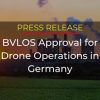The recent war in the Ukraine has only served to accentuate the growing demand for oil and gas products across the globe. This increasing need, combined with efforts worldwide to reduce methane emissions, is placing more focus on leak detection and repair (LDAR). In fact, according to a recent report by Grand View Research, the global leak detection and repair market size is expected to reach USD 27.89 billion by 2030, growing at a CAGR of 4.4% over the forecast period.
The new game changer in the industry is infrared cameras, spectrally filtered to pick up volatile organic compounds (VOCs), known as optical gas imaging, or OGI. This technology has been transforming the way Oil & Gas players are detecting leaks and fugitive emissions. But now, using these infrared sensors as the payload for autonomous drones marks a new era in leak detection, making it safer, more frequent, and thoroughly documented. The new technology is here to stay and here’s why.
Transforming the emissions inspection process
Whether you look at refinery emissions as a carbon footprint issue or a product loss issue – it’s an issue. And with such large quantities of emissions, optimizing emissions inspections is ripe to transform industry.
According to the EPA, a typical refinery or chemical plant can emit 600 to 700 tons per year of volatile organic compounds (VOCs) from leaking equipment, such as valves, connectors, pumps, sampling connections, compressors, pressure-relief devices, and open-ended lines. These same studies estimate that valves and connectors account for more than 90% of emissions leaking from equipment, with valves being the most significant source.
Outdated leak detection methods
Older inspection options entail an elaborate—and often hazardous—process that requires specialized staff to take measurements by walking through the equipment. The thing is, this technique can only conduct spot measurements. It can’t help inspectors pinpoint where the leak is coming from or where the gas is flowing. What’s more, the complexity and risk of these manual inspections means they are generally done about once every few months, letting any small leaks that arise in between inspections go unnoticed.
OGI camera drone inspections
OGI provides an affordable and accurate way to visualize escaping plumes of gas that would otherwise be invisible. The real magic happens when OGI is combined with autonomous drone inspection solutions.
Percepto’s drone-in-a-box solution for Oil & Gas augments manual inspections with autonomous on-site inspections, for increased safety and reliability. The data collection and analysis is automated by the Percepto AIM software, which includes a sophisticated cloud backend for AI-powered site inspections, monitoring, surveillance, and visual data collection and management. The inspection data is automatically captured, unified, analyzed, and visualized to provide actionable insights that are based on high quality information.
Enhanced productivity and optimized operations
Using autonomous drones equipped with OGI cameras and Percepto’s AIM software algorithms for inspections, offers several distinct advantages over those done with handheld cameras. There are the obvious benefits, such as more frequent inspections that essentially eliminate truck rolls –whether it’s inclement weather, hazardous physical conditions involving heights, or the lack of an available crew. AIM also solves the challenge of upcoming U.S. regulations by saving leak videos and keeping a historical timeline of emission inspections and leaks. All this translates directly into better productivity and lower costs by minimizing environmental infractions and product loss.
When automated, scanning for large emissions takes less time and can be performed more often, to find leaks before they turn into something more difficult to repair and more dangerous. This makes it much easier to catch the 1% of leaks that account for 99% of emissions. In other words, automating emission inspections with drones means never missing the big leaks—ever.
Accurate compliance with methane gas detection regulations
The EPA is set on having Oil & Gas companies find leaks to reduce the amount of methane being released. We’re seeing new OOOOa regulation favoring OGI because it so clearly provides an efficient, cost-effective means to meet the requirements and regulations. One super-important aspect of leak inspection is the accurate reporting and tracking of results and responses. It takes a sophisticated cloud-based inspection solution like Percepto AIM to house data in a way that makes it easy to capture, store, and access historical data.
Companies now need a historical timeline of where and when each leak was found, when it was fixed, when the repair was completed, the quality control deployed, and more. Any facility with accurate LDAR records decreases the chances of being targeted for audit enforcement actions and deflects the fines associated with rule violations. Percepto offers proof of inspection and can integrate data from multiple devices, like handheld or fixed cameras and other drones–while keeping all of the breadcrumbs along the way.
Increased safety for personnel and the surroundings
By automating emissions inspections, refineries not only prevent product loss, but also protect their employees. With drones, companies don’t need to send out employees into hazardous work environments, where they’re potentially exposed to emissions on a daily basis. And when fugitive emissions are detected, a drone with OGI payload can point maintenance crews to the exact location of the leak, minimizing their exposure during repairs.
Furthermore, by detecting emissions as they happen, companies can ensure large emissions won’t go undetected, safeguarding the environment and surrounding community.
Go higher – also when it comes to ROI
It’s not just better, it’s faster. At Percepto, we’re speeding up the process of OGI inspection. Our emission inspection solution using autonomous drones is much faster than the old methods using handheld cameras or soap and bubbles, allowing more frequent inspections. With sophisticated software that can ensure compliance with new regulations and easily maintain historical timelines, now is the time to ramp up and get on board with autonomous OGI inspections.
Percepto multi-mission drones offer solutions for everything from monitoring leaks and corrosion, to identifying safety hazards, and providing additional security and tracking for grounds and equipment. Our drones can be used to quickly and safely inspect tanks, confirming tank integrity – inspecting for dents, unclosed hatches, leaks, objects on the rooftops, corrosion, fenceline monitoring, and more. Checking for leaks in roofs and pipes, drones and robots do a general sweep of a facility, inspecting the ground and surrounding water for oil sheens, analyzing structural integrity, and detecting leaks and temperature discrepancies that may suggest an error. And in the event of a fire or security breach, drones are the safest and most effective first responders on site.
Stop in to learn more about how you can boost productivity, safety, and compliance at your facilities.





